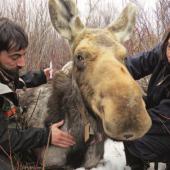Bear Prepared
How to stay safe.
In southwest Montana, bear encounters are becoming increasingly frequent—and sometimes violent. In 2012, there were two highly publicized fatalities in Yellowstone Park, and increased reports of bear-related incidents occurred last summer as well. A majority of attacks occur because the bear was surprised, or the victim came too close to a sow with cubs. Predatory attacks—instances of stalking or attacks with no clear motivation—are incredibly rare. Either way, here are some tips to help you avoid an unpleasant ursine encounter.
Prevention Tips
Hang your food. If camping overnight, try to hang your packs and definitely hang ALL food. Hang packs 12-15 feet off the ground, and eight feet from the tree trunk, with the bear hang and cooking area 200 feet from your campsite. Many backcountry campsites have poles hung between trees as pre-made hang areas.
Bear spray. Carry bear spray in an accessible place on your pack or belt, and make sure you know how to release the safety quickly and efficiently. Practice drawing, pointing, and even spraying—use a separate can to familiarize yourself with the range and spray pattern.
Hike in groups. Whenever possible, hike with three or more people, and make noise—especially in dense, overgrown areas—to avoid surprising a bear.
Avoid encounters. If you see a bear from a distance, it’s best to leave the area. If you must continue, make a wide detour around the bear.
In Case of an Encounter
Don’t run. Stand tall, even if the bear charges you. Remain calm and try to look as large as possible, but don’t look the bear in the eyes—it’s a sign of aggression. Let the bear know you’re not a threat. Back away slowly while speaking in soothing tones.
Spray away. Bear spray is a very effective deterrent. Discharge the spray when the bear is about 20 feet away, in 2-3 second bursts, spraying directly towards the bear’s face.
Know your bears. Different bear species call for different responses. If a grizzly makes contact, play dead—lie flat on your stomach and lace your hands behind your neck (alternatively, curl into the fetal position), and do not fight back until you’re sure the bear is not going to stop. For black bears, fight back immediately and vigorously—a rock or pocketknife to the face is your best bet. Regardless of species, once the bear leaves your immediate vicinity, wait several minutes before carefully checking to make sure the bear is gone.
Above all, when traveling in bear country, respect the wildlife and do all you can to avoid unnecessary encounters.












